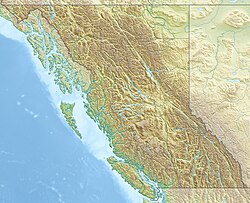Top Qs
Timeline
Chat
Perspective
Fernie Formation
Stratigraphic Unit in Western Canada From Wikipedia, the free encyclopedia
Remove ads
The Fernie Formation is a stratigraphic unit of Jurassic age. It is present in the western part of the Western Canada Sedimentary Basin in western Alberta and northeastern British Columbia.[2][3][4] It takes its name from the town of Fernie, British Columbia, and was first defined by W.W. Leach in 1914.[5]
Remove ads
Depositional history
The Fernie Formation consists of marine sediments that were deposited in the Sundance Sea. Deposition took place throughout most of the Jurassic period, starting during the Hettangian stage in some parts of northeastern British Columbia and continuing until the mid-Tithonian, as determined from its fossil assemblages, including ammonites, molluscs and microfossils.[3][4]
The sediments were sourced from the east during the deposition of the lower and middle units of the Fernie, where the coarser facies occur in the eastern part of the formation. In the uppermost Fernie, the coarsest material is found in the west, however, indicating a shift to sources in the west and south.[1][6]
Remove ads
Lithology
The Fernie Formation is composed primarily of brown and dark gray to black shales that range from massive with conchoidal fracture to laminated and highly fractured or papery. Phosphatic sandstone and limestone, including cherty limestone, occur locally in the lower parts of the formation; siltstone, sandstone, coquinas and oolitic limestone interbeds can occur in the center; glauconitic sandstone and siltstone can be present in the upper parts.[1][6]
Remove ads
Distribution
The Fernie Formation reaches a maximum thickness of 400 metres (1,310 ft) near Mount Allan in Alberta, and typically is about 70 to 150m (230 to 492 ft) thick. It thins toward the east, disappearing at about the longitude of Calgary. The formation is exposed in outcrops in the Kootenay region of southeastern British Columbia, in the foothills and front ranges of the Canadian Rockies in southwestern Alberta, and as far north as the Peace River Country in northeastern British Columbia.[1][6]
Relationship to other units
Summarize
Perspective
The Fernie Formation is conformably overlain by the Morrissey Formation in the south, by the Nikanassin Formation in central Alberta and by the Monteith Formation in northeastern British Columbia. It rests disconformably on Triassic units in the west, and unconformably on upper Paleozoic units such as the Schooler Creek Group and the Montney Formation farther east.[1][6]
Subdivisions
The Fernie Formation has the following subdivisions from top to base:
Remove ads
See also
- List of fossiliferous stratigraphic units in Alberta
- List of fossiliferous stratigraphic units in British Columbia
- Toarcian turnover
- Toarcian formations
- Marne di Monte Serrone, Italy
- Calcare di Sogno, Italy
- Sachrang Formation, Austria
- Posidonia Shale, Lagerstätte in Germany
- Ciechocinek Formation, Germany and Poland
- Krempachy Marl Formation, Poland and Slovakia
- Lava Formation, Lithuania
- Azilal Group, North Africa
- Whitby Mudstone, England
- Whiteaves Formation, British Columbia
- Navajo Sandstone, Utah
- Los Molles Formation, Argentina
- Mawson Formation, Antarctica
- Kandreho Formation, Madagascar
- Kota Formation, India
- Cattamarra Coal Measures, Australia
Remove ads
References
Wikiwand - on
Seamless Wikipedia browsing. On steroids.
Remove ads



